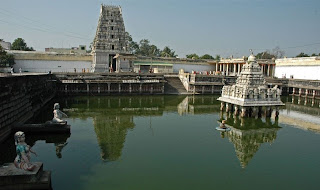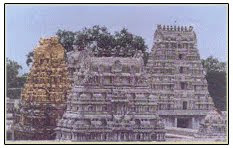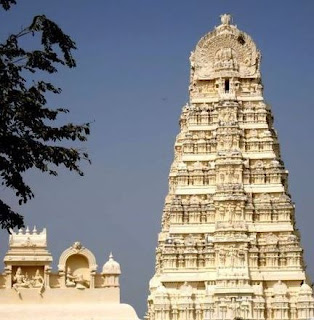Kanchipuram is called place of thousand temples. It has 128 temples. Each temple is associated with Hindu Puranas and legends. Kanchepuram is also noted for its Silk Sarees. Best quality of Silk sarees is woven here. It is a land of God and talented workmen of silk sarees. It is 3 hours travel from Chennai to Kanchipuram. Hotels in Kanchipuram are very close by to temples and bazaar where you can get good quality Kanchipuram Sarees. Here we will cover some important temples in Kanchipuram.
.
Kamatchi Amman Temple:
Built in the 14th century by the Cholas, this temple is dedicated to Goddess Kamakshi - the presiding deity of Kanchi. Here, the goddess is worshipped in the form of a Shri Chakra placed in front of the idol. Shri Sankaracharya worshiped her and formed the Shri Chakra in front of the deity. It radiates and vibrates the power of the Godess to the visiting devotees.
Shankaracharya is said to have defeated Buddhist philosophers in debate here. He worshiped here at the end of his life and his life force merged with Kamatchi. It is one of the three holy places of Shakthi worship in India, the other two being Madurai and Varanasi. The temple has a golden "gopuram" in the centre. Kamatchi blesses the devotees with riches, knowledge, and vibrant energy to work and gives things required for a happy life to her visitors and devotees.
People consider a visit to her in full moon night bestows with all the riches they require.
Some interesting legends associated with the above two temples:
According to Devi Bhagavatam, the lord of the ganas, Chitrakarma creates the image of a man out of the burnt ashes of Love; the Love god Manmatha who tried to distract Shiva from meditation and got burnt by the power of agni (fire) from the third eye of Shiva. Shiva names the new image, Bhanda or Panda, teaches him a powerful mantra and gives him the boon of being one and a half times as strong as his enemy, and empowering him as ruler for sixty thousand years. By the power of this mantra, one could gain half the might of one's adversary.
Unfortunately, because he was generated from the ashes of Shiva's wrath he is transformed into a fierce demon. Intoxicated with his new found power he proceeded to rampage the kingdom of the gods. Apprehending defeat and humiliation, there is nothing that any of the gods can do during the sixty thousand years when Siva is protecting Bhanda, but once this time has gone by, the gods try to find a way to destroy him and protect all the Celestials from the atrocities of a demon.
Devas in disguise of a parrot image together with the holy Trinity, Shiva, Vishnu and Brahma, summon the Divine Mother Adi Parashakti, Sri Lalita Ambika, in the form of Kamatchi. Legend has it that Kamatchi appeared in her ethereal form in a pit or cave (Bilakasa Swarupa) to save the Devas from Asuras agrees to stop Bhanda's efforts to overtake the city of the gods and destroy him.
The battle starts and gods rejoice in Kamatchi's growing success and worship her. Nonetheless, Bhanda is still alive and empowered. Sri Kamatchi Devi agrees to bless all of those worshiping her with progeny, fame, and virtue, among other things. As the city is being attacked by Bhanda, Kamatchi in the form of Parvati marries Lord Shiva, forming a strong allied army. At the same time, Kamatchi proclaims her independence while honoring her independence. Years go by and Kamatchi leaves her Consort to lead the army against Bhanda.
Bhanda does not regard an army of women as a serious threat, and laughs that Kamatchi is as soft and delicate as the flower. To Bhanda's dismay and the gods' delight, Kamatchi's army is very powerful. She is supported by strong women who work together to create unique weapons, particularly the noose and goad (which Lalita's icon often hold) in order to be successful. One after another, Bhanda's generals are defeated.
Kamatchi creates new gods to fight as the battle rages on, including Lord Ganesa, and he destroys many armies and Bhanda's brother. As a reward, Kamatchi grants him the right to be worshipped before all other gods. The battle rages on, all of Bhanda's family is killed, and finally he tries to save himself by creating powerful missiles to destroy Kamatchi. She is too powerful for him and sends Durga after him. Finally, it is a showdown between Bhanda and Kamatchi. She kills him using the kamesvara missile, which has an incredibly bright splendor. The deities praise Kamatchi for her courage and success. She agrees to bring back the god of Love, Manmatha and reunites him with his grateful wife Rathi Devi.
This myth shows how Kamatchi is the two forms of human nature simultaneously. She is able to be devoted to her Consort Siva, but to maintain the independence she needs to lead her army to war. She is fierce in her battles, but her most powerful weapons and warriors are created from her laugh and jubilance. Kamatchi shows people the way to deal with problems in their everyday lives. Her being is not an example for those who intend to lead an isolated life. Kamatchi shows how to live in balance, for people with numerous responsibilities. She demonstrates that it is possible to honor the family and other responsibilities, without disappointing anyone.
Another legend associated with this place:
Here is an interesting story:
A beautiful maiden called Sati, who is also called Dakshayani; one of the daughters of Prasuti and Daksha, an ancient creator god, loved Shiva. But her father Daksha forbade her marriage to Shiva.
Daksha got revenge by performing Yajna without offering the first Prasada to Siva; he did not pay any attention to Sati, when she showed up for the Yajna. Sati declared to the assembled galaxy of gods, goddesses and Rsis that she was ashamed to own the body given to her by her father. She performed Tapas and the internal heat generated by the Tapas consumed her life. Having heard the death of Sati, Siva, in a fit of anger, pulled his matted lock and flung it on the ground and performed the dance of destruction (tandava nritya) with Sati’s dead body on his shoulder, in the form of Bhairava.
From the fulgurant lock emerged a being, scraping the skies and heavens with a thousand arms, with three eyes shining like the sun, dark complexion like a rain clouds, fierce teeth, a garland of skulls, matted locks resembling ropes of fire, and a host of weapons at the ready. That was Virabhadra, a part manifestation of Siva in his fierce form, together with 7 other beings called Muneeswaras. They immediately sought and received their mission which is to annihilate Daksha and his sacrifice. Daksha met his death at the hands of Virabhadra.
Siva picked up the body of Sati and wandered all over the universe. Vishnu seeing Siva in such condition sent his discus, which cut the dead body of Sati into several pieces, which fell all over Indian subcontinent. Wherever the body parts fell, that ground became sacred. The womb portion of Sati fell in Kanchipuram, Tamil Nadu, which became the sacred site of temple (Sakti Peetha) for her in the form of Sr Kamatchi Amman.
Some more temples of interest in Kanchipuram:
Kailasanathar Temple is dedicated to Lord Siva. Iit is one of the earliest temples built by Rajasimha and his son Mahendra in the 8th century A.D. There are 58 small shrines situated round the main shrine. Fresco-style paintings adorn the inner walls of the shrines. Sandstone was used in the construction of this temple. It is the only temple at Kanchipuram which is not cluttered with the more recent additions of the Cholas and Vijayanagar rulers. Fragments of the eighth century murals which once graced the alcoves are a visible reminder of how magnificent the temple must have looked when it was first built.
Varadarajar temple is a massive and impressive edifice. This is another Vishnu temple on Hastagiri rock at the end of the town. The Hundred-Pillar-hall erected during the Vijayanagar period in this temple is noted for its exquisite sculptures. The ornamental rings carved out of a single stone in a chain at the four corners are the special features of the hall. The riders on horseback, beautiful figures of Rathi and Manmatha, exquisite temple jewelery are other notable features. This temple provides a glimpse of a 16th century pillared pavilion with an exuberant workmanship.
Kumarasamy temple or Skantha Kottam in Kanchipuram is a temple for Lord Muruga. It is modern temple when compared to other old historical temples. Here the famous ‘Kanthasashti Kavasam’ adoring the Lord Muruga, son of Lord Shiva and Parvathi was written by an aminent saint called ‘Kumarkurupara Swamikal’.
The visit to the Kanchipuram is so memorable with some good Kanchipuram Sarees. Indians especially Tamilian ladies wear Kanchipuram Sarees on all important and auspicious functions. It is prestigious for them wear Kanchipuram Sarees. Even many foreign visitors to South India love to wear Kanchipuram Sarees.
People of Kanchipuram hotels and the local people are very helpful in finding locating the temples and Kanchipuram Sarees shops.












Nice coverage of Kanchipuram and silk sarees. Will the Kanchipuram people will be helpfull to me too.
ReplyDelete